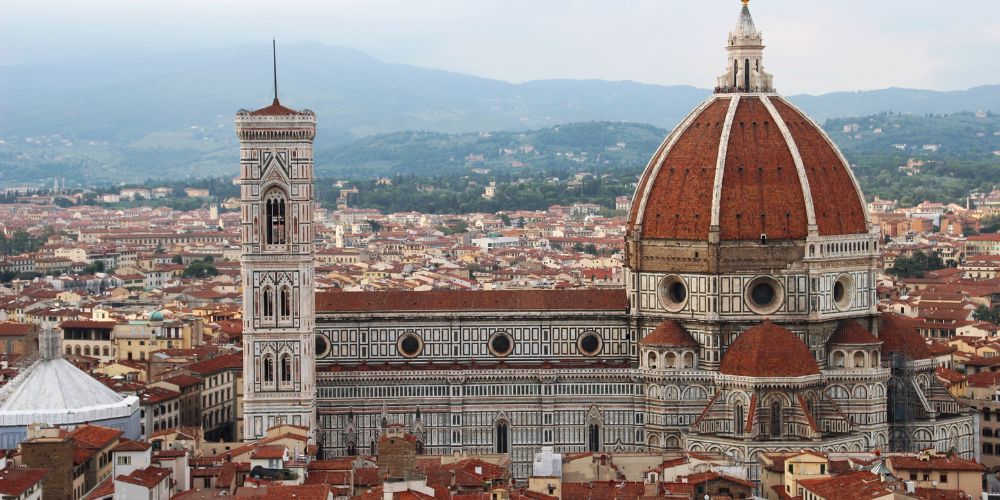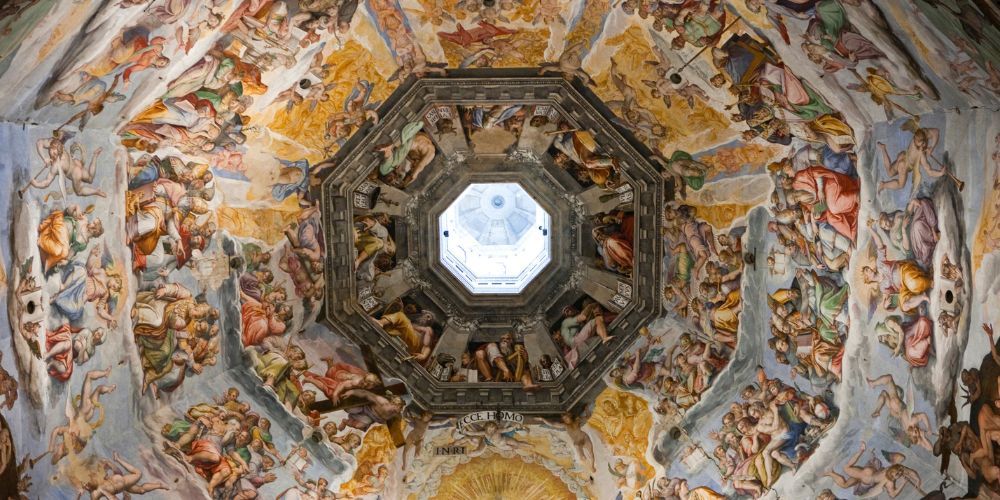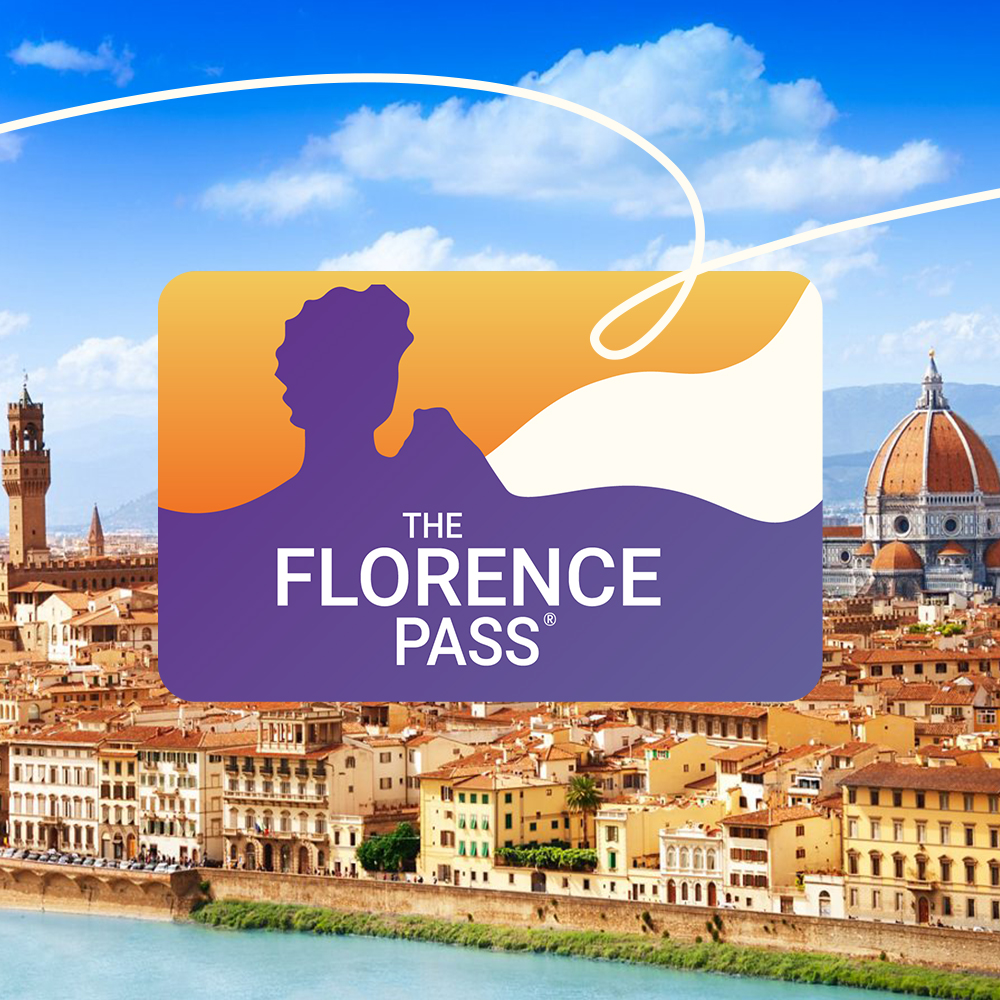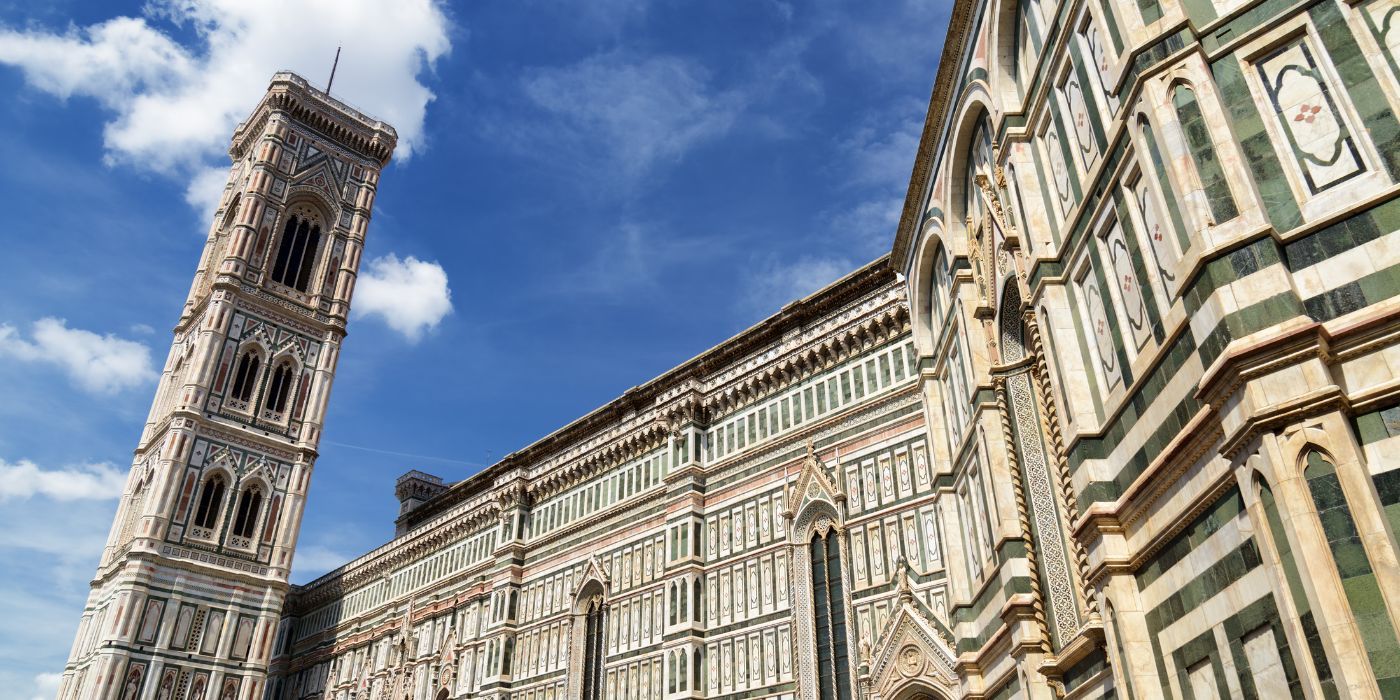Giotto’s Bell Tower, a masterpiece of Gothic architecture, stands 85 meters high next to the Florence Cathedral and completes the monumental complex.
From its height of 85 meters you can enjoy an enchanting view of the city: its silhouette and that of Brunelleschi’s dome characterize the skyline with their majesty and elegance.
Its unusual position alongside the facade gives it greater importance and makes sure to leave free space for the dome, a true masterpiece of architecture that with its record numbers has managed to challenge all the laws of physics and remain unmatched in the centuries to come.
Discover Giotto’s Tower Bell and Brunelleschi Dome with a guided tour
Giotto's bell tower and Florence Cathedral: info, skip the line tickets and guided tours

Ph Canva by Umbertop_100
Giotto’s bell tower is located in Piazza del Duomo, next to Florence Cathedral (Santa Maria del Fiore). To visit Giotto’s bell tower you will have to buy a single ticket that will also allow you to access the Cathedral, the Baptistery, the Brunelleschi Dome, the Opera del Duomo Museum and the Cathedral terraces.
The Bell Tower is open every day from 8.30 to 19.30 (on the day of Epiphany until 14) and to climb it you will have to face 414 steps. To visit the whole complex will require a minimum time of about 3 and a half hours, not counting any queues and breaks.
To reach the cathedral complex by public transport you can choose between different options, depending on where you are:
By train: the train station closest to the Piazza del Duomo is Santa Maria Novella, which is about 750 meters. From there you can walk or take a bus.
By bus: there are several bus lines that connect Florence with other Italian cities and stop near Piazza del Duomo, such as Flixbus, Itabus and Blubus. You can also take an urban bus that goes through the "Condotta" stop.
By tram: the Duomo complex is a 10-minute walk from the nearest tram station, Valfonda.
Skip the line to Giotto’s Campanile and Duomo complexGiotto’s bell tower: history

Ph Canva by Borisb17
The construction of bell tower began with Giotto in 1334: the artist was engaged in the construction of the Cathedral, but at a certain point he felt the need to leave the building behind and concentrate only on the tower. After his death in 1337 it was Andrea Pisano to continue the work until 1348, when the plague epidemic forced to stop the construction site. Francesco Talenti completed the construction in 1359.
The bell tower has a total height of 85 meters and is richly decorated with polychrome marble and sculptures by various artists, including Andrea Pisano, Donatello and Luca della Robbia. Giotto’s style is particularly evident in the refinement of the marble decoration: white from the quarries of Campiglia Marittima and Pietrasanta, green from Prato (serpentine) and red from Monsummano Terme, Siena and Stazzema.
The sculptures have all been replaced with copies and the originals are kept in the Opera del Duomo Museum: they represent one of the most complete sculptural cycles in the history of art, from the Middle Ages to the present day.
Discover the Tower Bell, the Opera del Duomo Museum and the BaptisteryWhat to see with Giotto’s Tower Bell: the Florence Cathedral

Ph Canva by Gim42
The Florence Cathedral or Santa Maria del Fiore is one of the most famous and admired symbols of the city and of whole Italy. Its imposing masonry dome, designed by Filippo Brunelleschi, dominates the Florentine panorama with its elegance and majesty.
The construction of the cathedral began in 1296 on a project by Arnolfo di Cambio and ended in 1436 with the consecration by Pope Eugene IV. The current facade in neo-Gothic style is made of polychrome marble and is instead the result of a nineteenth-century intervention. The cathedral houses works of art of great value, such as the Baptism of Christ by Andrea del Verrocchio and Leonardo da Vinci, the funeral monument to Brunelleschi by Luigi Pampaloni and the frescoes of the Last Judgement by Giorgio Vasari and Federico Zuccari. The cathedral is also the seat of the Archdiocese of Florence and can accommodate up to thirty thousand faithful.
Brunelleschi’s Dome is the cover of the Florence Cathedral cruise: it is the largest masonry dome ever built, with an internal diameter of 45.5 meters, an external 54.8 meters and a height of 116 meters. It was built between 1420 and 1436 by Filippo Brunelleschi, who won a competition organized by the Opera del Duomo. The interior is decorated with frescoes by Vasari and Zuccari representing the Last Judgment.
The Baptistery of San Giovanni is located next to the cathedral of Santa Maria del Fiore: dedicated to the patron saint of the city, it was for centuries the place where the Florentines were baptized. The Baptistery has an octagonal plan typical of medieval baptisteries and is decorated with white and green marbles with geometric patterns. Its bronze doors are the work of Andrea Pisano and Lorenzo Ghiberti, and represent the most important biblical scenes. The interior is decorated with Byzantine mosaics depicting the Last Judgment, the life of Saint John the Baptist and other events.
The Opera del Duomo Museum is part of the Cathedral complex and contains many of the original works of art created for the exteriors of Santa Maria del Fiore and later replaced by copies to preserve its integrity: here you can admire Gothic and Renaissance sculptures by artists such as Donatello, Michelangelo, Ghiberti and Brunelleschi.
Discover the Florence Cathedral with priority entranceAbout the author
Written on 08/05/2023




Sara Milanolo
Organize with us your visit to the Giotto's Bell Tower and Florence Cathedral: here you can find all the info and tickets skip the line.